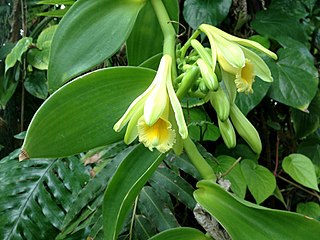
Vanilla is a spice derived from orchids of the genus Vanilla, primarily obtained from pods of the Mexican species, flat-leaved vanilla (V. planifolia).

Dioscorea alata, also known as purple yam, ube, or greater yam, among many other names, is a species of yam. The tubers are usually a vivid violet-purple to bright lavender in color, but some range in color from cream to plain white. It is sometimes confused with taro and the Okinawa sweet potato, although D. alata is also grown in Okinawa, where it is known as beniimo (紅芋). With its origins in the Asian tropics, D. alata has been known to humans since ancient times.

Afgekia is a small genus of large perennial climbing shrubs native to Thailand in Asia, belonging to the family Fabaceae.
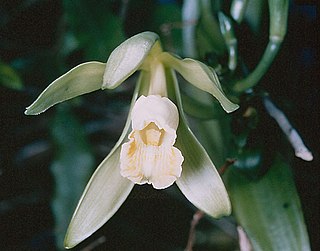
Vanilla, the vanilla orchids, forms a flowering plant genus of about 110 species in the orchid family (Orchidaceae). The most widely known member is the flat-leaved vanilla, native to Mexico and Belize, from which commercial vanilla flavoring is derived. It is the only orchid widely used for industrial purposes in flavoring such products as foods, beverages and cosmetics, and is recognized as the most popular aroma and flavor. The key constituent imparting its flavour is the phenolic aldehyde, vanillin.

Pandanus is a genus of monocots with some 750 accepted species. They are palm-like, dioecious trees and shrubs native to the Old World tropics and subtropics. The greatest number of species are found in Madagascar and Malaysia. Common names include pandan, screw palm, and screw pine. They are classified in the order Pandanales, family Pandanaceae.
In the 2005 dengue outbreak in Singapore, a significant rise in the number of dengue fever cases was reported in Singapore, becoming the country's worst health crisis since the 2003 SARS epidemic. In October 2005, there were signs that the dengue fever outbreak had peaked, as the number of weekly cases had declined and the outbreak of this infectious disease declined by the end of 2005.
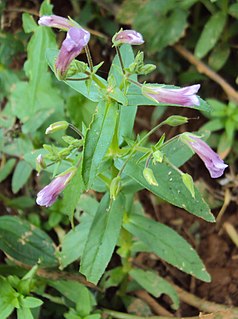
Limnophila aromatica, the rice paddy herb, is a tropical flowering plant in the family Plantaginaceae. It is native to Southeast Asia, where it flourishes in hot temperatures and grows most often in watery environments, particularly in flooded rice fields. It is called ngò ôm or ngò om or ngổ in Vietnam and used as an herb and also cultivated for use as an aquarium plant. The plant was introduced to North America in the 1970s due to Vietnamese immigration following the Vietnam War. It is called "ma om" (ម្អម) in Khmer. It is used in traditional Cambodian soup dishes and Southern Vietnamese cuisine. It can grow in flooded rice paddies during wet season but it grows best on drained but still wet sandy soil of harvested rice paddies for a few months after the rainy season ended. It dies out soon after it flowers. Rural Cambodians often harvest them and put them on the roof of their houses to dry for later use.

Pandanus amaryllifolius is a tropical plant in the Pandanus (screwpine) genus, which is commonly known as pandan. It has fragrant leaves which are used widely for flavouring in the cuisines of Southeast Asia and South Asia.

Vanilla planifolia is a species of vanilla orchid. It is native to Mexico and Belize. It is one of the primary sources for vanilla flavouring, due to its high vanillin content. Common names include flat-leaved vanilla, and West Indian vanilla. Often, it is simply referred to as "the vanilla". It was first scientifically named in 1808. With the species' population in decline and its habitats being converted to other purposes, the IUCN has assessed Vanilla planifolia as Endangered.

Cheilocostus speciosus, or crêpe ginger, is a species of flowering plant in the family Costaceae. Some botanists have now revived the synonym Hellenia speciosa for this species.

The National Parks Board (NParks) is a statutory board under the Ministry of National Development of the Government of Singapore.
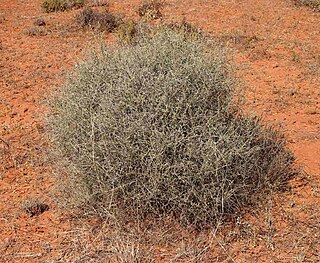
Maireana aphylla, also known as cotton bush or leafless bluebush, is a leafless shrub that is endemic to Australia. It is usually rounded in form and grows to around 1.5 metres in height.

The Southern Ridges comprise 10 kilometres (6.2 mi) of trails connecting three parks along the southern ridge of Singapore. Some of the attractions along these trails include its greenery and the connecting bridges. This project linked up the parks between the Kent Ridge Park and HarbourFront. The idea to link these parks was coined in 2002 by Urban Redevelopment Authority (URA) and it took 2 years to complete and cost S$25.5 million.

HortPark is a 9-hectare (22-acre) park and garden located in the southwestern part of Singapore. It opened in December 2007, but it was not until 10 May 2008 that it was officially launched by Prime Minister Lee Hsien Loong.

Anabasis is a genus of plants in the subfamily Salsoloideae of the family Amaranthaceae. It is distributed in southern Europe, North Africa, and Asia.

Cyanotis cristata is a species of perennial plants in the family Commelinaceae. It is native to Indian Subcontinent, southern China, Southeast Asia, Ethiopia, Socotra, Mauritius, Java, and the Philippines.

Iris aphylla is a species in the genus Iris, it is also in the subgenus Iris, and in the section Iris. It is a rhizomatous perennial, from Asia to Europe. It is found in Azerbaijan, Russian Federation, Czech Republic, Germany, Hungary, Poland, Belarus, Ukraine, Bulgaria, Albania, Former Yugoslavia, Italy, Romania and France. It has dark green or bright green, sword-shaped, long grass-like leaves, that die/fade away in the winter. It also has a slender stem, with several branches and green and purplish spathes. It has 3–5 large flowers, in shades of bright purple, purple, violet, dark blue, blue-violet and dark violet, which bloom between spring and early summer. Occasionally, they re-bloom in the autumn, before the seed capsule is formed. It is cultivated as an ornamental plant in temperate regions. There is one known subspecies Iris aphylla subsp. hungarica Hegi.
Anabasis aphylla is a species of flowering plant in the family Amaranthaceae, native to the region surrounding the Caspian Sea, Central Asia, and Xinjiang and western Gansu provinces of China. A many-branched shrub usually found growing in alluvial fans and dune swales, it is sometimes planted to catch blowing soil and stabilize sand dunes. The alkaloid anabasine was named for this toxic species, from which it was first isolated by Orechoff and Menschikoff in the year 1931. Anabasine was widely used as an insecticide in the former Soviet Union until 1970.

Lepisanthes alata, also called the Johore tree, blimbing cina, ceri or engkili, is a species of flowering plant, a tropical forest fruit-tree in the lychee family, that is native to Southeast Asia.
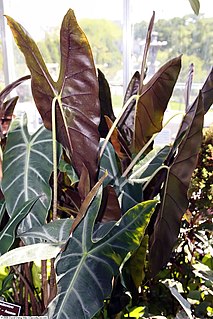
Alocasia longiloba is a species of flowering plant in the family Araceae. It is the namesake of a species complex. The complex has a widespread distribution; Guangdong, Hainan, and southern Yunnan in China, mainland Southeast Asia, and western and central Malesia.


















